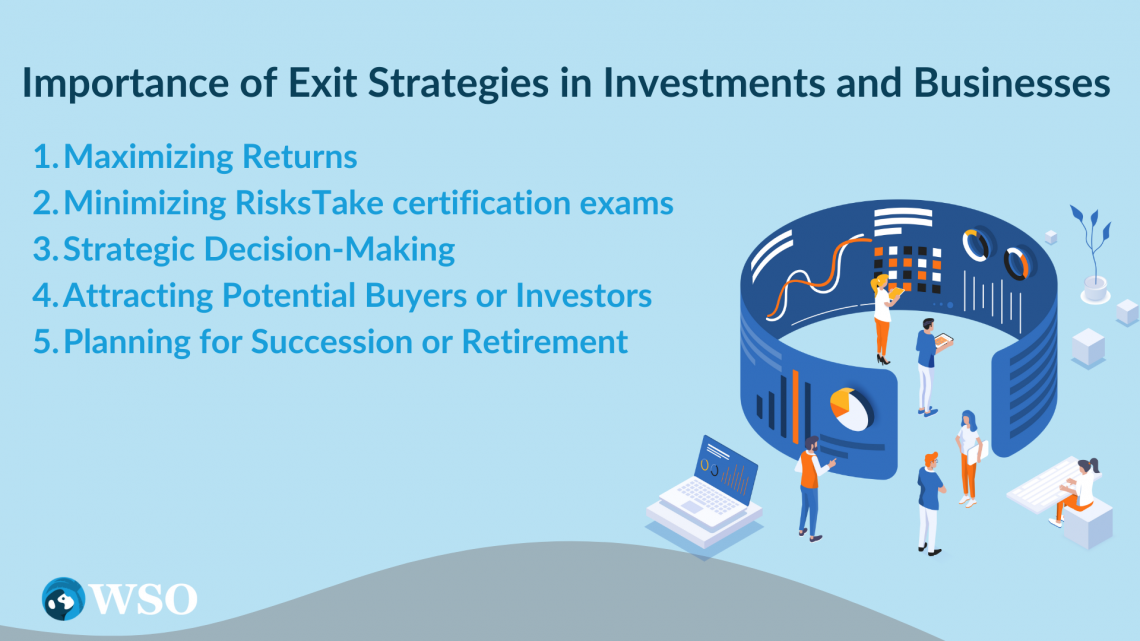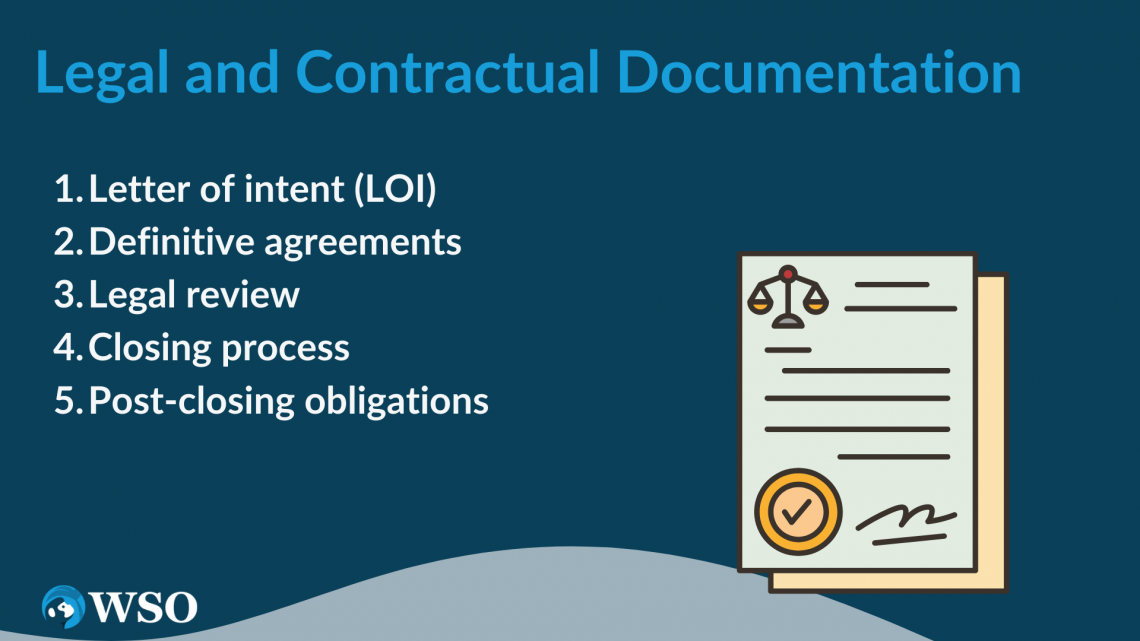Exit Strategy
It is a strategic approach designed to optimize returns, minimize risks, and achieve specific goals.
What Is an Exit Strategy?
An exit strategy serves as a predetermined plan that outlines how investors or business owners intend to exit or transition from their investment or business venture. It is a strategic approach designed to optimize returns, minimize risks, and achieve specific goals.

Whether an investor looking to cash out on their investment or a business owner seeking to retire or move on to new opportunities, it provides a clear roadmap for a successful transition.
The purpose of an exit strategy goes beyond simply exiting a venture. It involves careful consideration of market conditions, financial projections, and investor objectives to determine the most suitable path forward.
An effective exit strategy maximizes the value of the investment or business and ensures a smooth and seamless transition for all stakeholders involved. It allows investors to reap the rewards of their investment while minimizing potential risks.
It provides clarity and direction for business owners, allowing them to plan for the future and achieve their desired outcomes.
In a dynamic and ever-changing business landscape, having a well-defined exit strategy is essential to enhance investments and businesses' overall success and sustainability.
Key Takeaways
- Exit strategy is a predetermined plan that outlines how investors or business owners intend to exit or transition from their investment or business venture.
- Exit strategies are a strategic approach designed to optimize returns, minimize risks, and achieve specific goals.
- An effective exit strategy goes beyond simply exiting a venture; it involves careful consideration of market conditions, financial projections, and investor objectives to determine the most suitable path forward.
- An exit strategy aims to ensure a smooth and successful transition while maximizing the value of the investment or business.
- It provides clarity and direction, allowing investors and business owners to plan for the future and achieve their desired outcomes.
- Exit strategies help mitigate risks, adapt to changing market conditions, and attract potential buyers or investors.
- It enhances overall success and sustainability by providing a clear roadmap for achieving financial goals and ensuring a seamless transition for all stakeholders involved.
The Importance of Exit Strategies in Investments and Businesses
Exit strategies are crucial in investments and businesses, providing a roadmap for achieving financial goals and ensuring a smooth and successful transition.

Here are the key reasons why exit strategies are important:
Maximizing Returns
It allows investors or business owners to capitalize on their investments by realizing maximum returns.
It helps define the optimal time and method for exiting the investment or business, taking into account market conditions, growth potential, and financial goals.
By strategically planning their exit, investors can aim to sell at a favorable price and maximize their profits.
Minimizing Risks
Exit strategies mitigate risks associated with investments or businesses. They provide an exit plan in case of unforeseen circumstances, such as economic downturns, industry disruptions, or changes in personal circumstances.
NOTE
With an exit strategy, investors and business owners can proactively respond to potential risks and protect their financial interests.
Strategic Decision-Making
An exit strategy guides strategic decision-making throughout the investment or business journey. It helps stakeholders focus on long-term goals and make informed choices regarding growth strategies, resource allocation, and market positioning.
Attracting Potential Buyers Or Investors
It makes the investment or business more attractive to potential buyers or investors. It demonstrates a clear plan for future growth and profitability, instilling confidence in the investment opportunity.
A well-thought-out exit strategy can increase the likelihood of securing a favorable deal, attracting strategic buyers or investors who see value in the opportunity.
Planning For Succession Or Retirement
It is crucial for planning succession or retirement for business owners. It provides a framework for transitioning ownership or management responsibilities to the next generation or external parties.
By having an exit strategy in place, business owners can ensure a smooth handover, preserve the company legacy, and secure the financial well-being for themselves and their families.
The Types of Exit Strategies
There are various types of exit strategies that investors and business owners can employ to transition out of their investments or businesses.

These exit strategies provide different avenues for realizing value and achieving specific objectives. Each exit strategy has its considerations, benefits, and implications, allowing investors and business owners to choose the most suitable path based on their goals and circumstances.
Initial Public Offering (IPO)
An Initial Public Offering (IPO) is an exit strategy wherein a privately held company introduces its shares to the public market.
Choosing an IPO as a strategic move results in the company transforming into a publicly traded corporation, facilitating the involvement of investors in the purchase and sale of shares on the stock market.
This strategic move offers a remarkable opportunity for the initial investors and founders to actualize their investment gains by selling their shares to the public.
Through the IPO process, the company unlocks the potential for widespread ownership and trading, opening doors for investors to participate in its growth and success.
An IPO can provide significant capital infusion for the company's growth and expansion while also increasing its visibility and credibility in the market.
Merger Or Acquisition
A merger or acquisition exit strategy involves selling the company to another company. In a merger, two companies combine to form a new entity, while in an acquisition, one company buys another.
It can be beneficial when the acquiring company offers a favorable price or brings synergies that enhance the value of the business.
NOTE
Mergers and acquisitions can provide liquidity to investors, facilitate business expansion, and enable access to new markets, technologies, or resources.
Management Buyout (MBO)
A management buyout (MBO) is an exit strategy where a company's existing management team or employees purchase a majority stake from the current owners or shareholders. This strategy allows management to take control of the company and become the new owners.
MBOs are often chosen when the current owners retire, want to sell their shares, or believe that the existing management team is best positioned to continue the company's success.
MBOs offer continuity for employees, preserve company culture, and can lead to smoother transitions.
Strategic Sale
A strategic sale exit strategy involves selling the business to a strategic buyer who sees value in acquiring the company for its complementary products, market position, or synergistic benefits. Strategic buyers may be competitors, suppliers, customers, or companies in related industries.
The strategic sale allows the business owners to capitalize on their hard work and accomplishments by selling to a buyer who can unlock additional value or market opportunities.
NOTE
This exit strategy can also result in strategic partnerships or collaborations that benefit both parties involved.
Liquidation
Liquidation is an exit strategy where the business is shut down, and its assets are sold off to repay debts and distribute the remaining proceeds to shareholders or owners.
It is typically chosen when the business is no longer financially viable or when the owners decide to terminate operations.
Liquidation can provide a clean and final closure for the business, allowing investors to recover whatever value is left in the company's assets. However, it is often considered the least favorable exit strategy as it rarely maximizes investor returns.

Trade proprietors and speculators ought to carefully evaluate and plan their exit strategy to maximize value, minimize risks, and achieve their desired results.
Identifying potential buyers or investors in an Exit Strategy
Identifying potential buyers or investors is critical in executing an exit strategy. This process involves actively seeking out individuals or entities interested in acquiring or investing in the business.

Here are two effective approaches to identifying potential buyers or investors:
Networking And Relationship Building
Networking and relationship building plays a crucial role in identifying potential buyers or investors. This involves reaching out to industry contacts, attending industry events, and engaging in professional associations or organizations.
The process includes:
- Building a network: Actively connect with individuals or companies within the industry interested in acquiring or investing in businesses like yours
- Industry events: Attend conferences, seminars, trade shows, and networking events to meet potential buyers or investors and establish relationships
- Pitch events: Participate in pitch events or competitions where entrepreneurs present their businesses to potential investors.
- Online platforms: Utilize online platforms, such as industry-specific forums, social media groups, or business networking platforms, to connect with potential buyers or investors.
Engaging With Investment Bankers Or Brokers
Engaging with investment bankers or brokers is another effective approach to identifying potential buyers or investors.

The process typically involves:
- Hiring an investment banker or broker: Select a reputable investment banker or broker with expertise in your industry to assist in identifying potential buyers or investors.
- Market research and analysis: The investment banker or broker conducts market research and analysis to identify potential strategic buyers or investors based on industry trends, market dynamics, and previous transaction data.
- Confidentiality and marketing materials: The investment banker or broker prepares marketing materials, such as a confidential information memorandum, to highlight the business's strengths and attract potential buyers or investors while maintaining confidentiality.
- Targeted outreach and negotiations: The investment banker or broker engages in targeted outreach to potential buyers or investors, presenting the opportunity and initiating negotiations on behalf of the seller. They facilitate discussions, manage inquiries, and help negotiate deal terms.
- By leveraging networking, relationship building, and engaging with investment bankers or brokers, business owners can expand their reach, tap into relevant networks, and access a pool of potential buyers or investors.
These approaches increase the likelihood of finding the right match and achieving a successful exit transaction. Maintaining confidentiality throughout the process and working closely with professionals with experience in mergers, acquisitions, or investment transactions are crucial.
The Process of Negotiating and Executing the Exit Transaction
Negotiating and executing the exit transaction involves several key steps that ensure a smooth and successful transition.

Let's explore the process in three main stages: due diligence, valuation negotiations, and legal and contractual documentation.
Due Diligence Process
During the due diligence process, the potential buyer or investor delves into every nook and cranny of the company, exploring its financial, legal, operational, and commercial aspects with keen scrutiny.
This thorough examination serves a vital purpose: to confirm the authenticity and precision of the information provided, gauge the potential risks and liabilities involved, and unearth any hidden challenges that could impact the value or sustainability of the business.
It's like peeling back the layers of an onion to uncover the core truth. Due diligence involves meticulous investigation, data analysis, legal assessments, and comprehensive assessments to ensure that all bases are covered.
Due diligence is an essential step in the journey toward making an informed decision and ensuring a successful investment or acquisition.

The following are the common steps taken in the process:
- Document review: The buyer reviews financial statements, contracts, legal documents, intellectual property, customer agreements, and other relevant records.
- Site visits: The buyer may visit the company's premises to assess operations, infrastructure, and assets.
- Interviews: Key stakeholders, including management, employees, and customers, may be interviewed to gather additional information.
- Financial analysis: The buyer evaluates the company's financial performance, including revenue, expenses, cash flow, and projections.
- Risk assessment: Potential risks, such as legal disputes, regulatory compliance issues, or environmental liabilities, are identified and analyzed.
Valuation Negotiations
Valuation negotiations involve determining the business's fair market value and agreeing on the purchase price or terms of the exit transaction.

This stage typically includes the following steps:
- Business Valuation: Both parties may engage with valuation experts to assess the company's worth based on factors like financial performance, growth potential, market conditions, and industry comparables.
- Initial offer: The buyer presents an initial offer or proposal to the seller, taking into account the valuation findings, market conditions, and investment objectives.
- Counteroffers and negotiations: The seller may respond with a counteroffer, and negotiations take place to reach a mutually acceptable purchase price or deal structure.
- Purchase agreement: Once the purchase price is agreed upon, a formal purchase agreement is drafted, outlining the terms and conditions of the transaction, including any contingencies, warranties, or representations.
Legal and Contractual Documentation
The final stage involves preparing and executing the legal and contractual documentation necessary to complete the exit transaction.

This stage includes:
- Letter of intent (LOI): A non-binding LOI may be signed by both parties, outlining the key terms and conditions of the transaction, including the purchase price, deal structure, and any contingencies.
- Definitive agreements: Once the LOI is agreed upon, definitive agreements are drafted, which may include a purchase agreement, asset or stock purchase agreement, non-compete agreements, employment contracts, or other relevant legal documents.
- Legal review: Both parties engage their legal advisors to review the agreements, ensure compliance with applicable laws, and protect their respective interests.
- Closing process: The closing process involves the final execution of the agreements, payment of the purchase price, transfer of assets or shares, and any necessary regulatory approvals or filings.
- Post-closing obligations: The agreements may also outline any post-closing obligations, such as transition assistance, employee retention, or earn-out provisions, which ensure a smooth transition and continuity of operations.
- Negotiating and executing the exit transaction requires careful attention to detail, effective communication between both parties and the involvement of experienced legal and financial professionals.
Each step plays a crucial role in ensuring a successful exit and maximizing value for all stakeholders involved.
Real-life Successful Exit strategies
Successful exit strategies can be seen through notable acquisitions in the business world.

One such example is Facebook's acquisition of Instagram, a popular photo-sharing app, which showcased the effectiveness of strategic acquisitions. Another example is Nestlé's acquisition of Atrium Innovations, a leading provider of natural health products.
These successful exit strategies highlight the power of identifying synergistic opportunities and leveraging resources to achieve strategic objectives and maximize value.
Facebook's Acquisition Of Instagram
Back in 2012, Facebook, the behemoth of social media, executed a masterstroke in its exit strategy playbook by securing Instagram. This beloved photo-sharing app has captured the hearts of millions.
At that time, Instagram was riding tall on its wave of popularity, boasting an ever-growing client base and skyrocketing engagement.

With a canny eye for potential, Facebook saw the golden opportunity that Instagram presented, viewing it as a gateway to expand its impact within the versatile and visual substance domain.
The acquisition wasn't just a simple exchange; it was a vital move that allowed Instagram to tap into Facebook's colossal assets, huge client base, and unrivaled publicizing capabilities.
Simultaneously, Facebook secured a sturdy foothold within the fiercely competitive versatile photo-sharing market, cementing its position as a dominant drive within the digital scene.

The securing of Instagram by Facebook is a momentous confirmation of the control of recognizing undiscovered potential, making striking moves, and harvesting the rewards of a well-executed exit methodology.
It was a game-changing move that brought together two tech giants, creating synergies and unleashing a modern time of development within social media and visual narrating.
The successful integration of Instagram into the Facebook ecosystem resulted in substantial growth and value creation for both companies.
Today, Instagram continues to thrive under the Facebook umbrella, attracting billions of users and generating significant revenue through advertising.
Nestlé's Acquisition Of Atrium Innovations
In 2017, Nestlé, the multinational food and beverage company, executed a successful exit strategy by acquiring Atrium Innovations, a leading provider of natural health products.

The acquisition allowed Nestlé to diversify its product portfolio and tap into Atrium's expertise in research, development, and manufacturing of natural health products.
Atrium Innovations benefited from Nestlé's global distribution network, marketing capabilities, and financial resources.
The acquisition proved to be a strategic move for Nestlé as it enabled the company to strengthen its position in the health and wellness market and cater to the evolving preferences of health-conscious consumers.
The successful integration of Atrium Innovations helped Nestlé drive revenue growth and enhance its competitive advantage in the industry.

These successful exit strategies highlight the importance of strategic acquisitions in achieving growth, market expansion, and value creation.
In both cases, the acquirers recognized the potential synergies and strategic fit with the target companies, allowing them to leverage their strengths and resources to unlock additional value.
The key to a successful exit strategy is conducting thorough due diligence, assessing market dynamics, and identifying opportunities aligning with the acquirer's strategic objectives.
Exit Strategy Conclusion
Exit strategies play a pivotal role in investments and businesses, providing a roadmap for achieving financial goals and ensuring a successful transition.

By defining a clear plan for exiting or transitioning from an investment or business venture, stakeholders can maximize returns, minimize risks, and attract potential buyers or investors.
The strategic decision-making facilitated by exit strategies helps investors and business owners stay focused on long-term objectives and adapt to changing market conditions.
Furthermore, exit strategies offer a means of planning for succession, retirement, or unforeseen circumstances, ensuring a smooth handover of ownership or management responsibilities.
Successful exit strategies are exemplified by notable acquisitions such as Facebook's acquisition of Instagram and Nestlé's acquisition of Atrium Innovations.

These strategic moves demonstrated the value of identifying synergistic opportunities, expanding market presence, and capitalizing on industry trends.
In summary, exit strategies provide clarity, direction, and a framework for achieving desired outcomes. They allow stakeholders to mitigate risks, make informed decisions, and capitalize on opportunities.
Ultimately, a well-defined exit strategy enhances investments and businesses' overall success, sustainability, and financial well-being, positioning stakeholders for a smooth and profitable transition.
If you have a path in finance that interests you, but you don’t have the relevant skills. Check out Wall Street Oasis’ contents, starting with its financial modeling course, where you can learn crucial technical skills needed in the industry taught by years of finance professionals from bulge bracket banks and private equity firms!





or Want to Sign up with your social account?